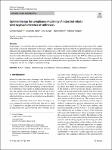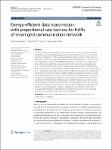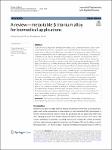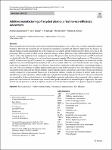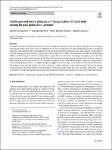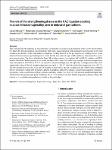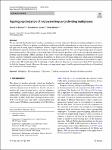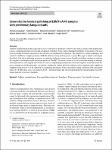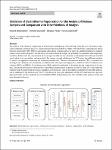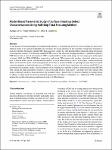Search
Author
- Osman, Ahmed I. (5)
- Daqing, Ma (3)
- Jorgensen, Ed (3)
- Li, Yan (3)
- next >
Subject
- kinh tế (26)
- Economics (12)
- programming (10)
- XRD (10)
- next >
Date issued
- 2020 - 2025 (2128)
- 2010 - 2019 (129)
- 2000 - 2009 (9)
- 1999 - 1999 (1)
Has File(s)
Search Results
In this paper a cost and time efficient approach to setup a compliance model for industrial robots is presented. The compliance model is distinctly determined by the gear’s stiffness parameters which are tuned by an optimal design of experiments approach. The experimental setup consists of different poses of the robot’s axes together with the applied force at the tool center point (TCP). These robot poses represent together with defined forces the experimental setup where the deviation of the robot under defined force is measured. Based on measurements of the displacement of the TCP the stiffness parameters for the compliance model are estimated and afterwards validated in new experiments. The efficiency of this approach lies in the reduced amount of experiments that are needed to i... |
In smart grid, the neighborhood area network (NAN) serves as a bridge connecting smart meters and meter data management system (MDMS) and is one of the most important components of the smart grid communication network. In this work, we study the energy-efficient data transmissions from NAN gateways (i.e., routers) to the concentrator that connects the MDMS. Particularly, to assure that each router associated with diverse number of associated smart meters can achieve a required data rate, a set of proportional rate fairness constraints are imposed into the optimization problem. In this case, an optimization problem that balances energy efficiency and fairness is formulated. |
Titanium and its alloys have already been widely used as implant materials due to their outstanding mechanical characteristics and biocompatibility. Notwithstanding this, researchers and businesses alike have continued to actively pursue superior alloys since there are still problems which need urgent consideration. One of these is a noteworthy difference in the implant material’s elastics modulus and that of natural bone, which result into an issue of stress shielding. With prolonged use Ti alloys releases dangerous ions. The Ti alloy surface has a low bioactivity, which prolongs the healing process. β-Ti alloys could be used as viable alternatives when creating dental implants. |
Plastic materials have been widely used to replace metals in functional parts due to their lower cost and comparable technical properties. However, the increasing use of virgin plastic material in consumer and industrial applications has placed a significant burden on waste management due to the volume of waste created and the potential negative effects of its end-of-life processing. There is a need to adopt circular economy strategies such as plastic recycling within industrial applications in order to reduce this significant waste management pressure. The present study used recycled polylactic acid (PLA) material as a feedstock for the 3D printing of a centrifugal semi-open pump impeller. The technical performance of 3D printed recycled PLA material and virgin PLA material was com... |
Conventional means of producing material via metal casting have long been used for centuries. In spite of its advantages in producing durable parts with lower cost implications and the accommodation of large part production, this conventional approach is still characterized by the challenges of high lead time in patterns production, poor surface finish, and the need for secondary manufacturing operations, which always leads to material loss. Hence, the introduction of additive manufacturing (AM) to metal casting process has been immensely recognized because of its huge advantages in negating some of the challenges encountered in the conventional route. However, the inconsistency in the material properties (such as density, strength, elastic modulus, dimensional accuracies, surface f... |
This work presents the influence of microstructural constituents on liquation crack formation in the cast Ni-based superalloy, René 108. The investigation was divided into three parts: characterisation of the material's microstructure in pre-weld condition, hot ductility studies and analysis of liquation cracking induced by the gas tungsten arc welding process. Using advanced electron microscopy techniques it is shown that the base material in pre-weld condition is characterised by a complex microstructure. The phases identified in René 108 include γ matrix, γ' precipitates, MC and M23C6 carbides, and M5B3 borides. Based on Gleeble testing, it was found that René 108 is characterised by high strength at elevated temperatures with a maximum of 1107 MPa at 975 °C. As a result of const... |
We use material-distribution-based topology optimization to design a three-port frequency dividing multiplexer at microwave frequencies. That is, by placing a good electric conductor inside the design domain, we aim to design a passive device that splits the incoming signal’s frequencies into two frequency bands and transmits them to their respective output ports. The Helmholtz equation models the time-harmonic wave propagation problem. We solve the governing equation using the finite element method. The adjoint variable method provides the required gradients, and we solve the topology optimization problem using Svanberg’s MMA algorithm. In this study, we present a technique for modeling the distribution of a good electric conductor within the design domain. |
Additive manufacturing technologies have several well-known advantages; however, the surface quality of the printed parts is poor, compromising the corrosion and mechanical properties. Thus, surface finishing treatments are necessary. The most post-processing treatments proposed in the literature are mechanical or chemical. The formers are contact techniques and cannot be suitable for complex geometry, while the latter use strong and dangerous reagents. This paper is aimed to investigate the effect of the electropolishing treatment, a contactless technique, using an eco-friendly electrolytic solution in reducing the roughness and improving the fatigue properties of Ti6Al4V specimens produced by electron beam melting technology. Several parameters affecting the effectiveness of the e... |
The analysis of the chemical composition of biomass plays an important role in all steps of the life cycle of biomass, especially in thermal conversion processes. Electrothermal vaporization (ETV) coupled with inductively coupled plasma optical emission spectrometry (ICP-OES) is a promising approach for biomass analysis as almost no sample preparation is required, samples can be analysed quickly, and the release of elements from the sample can potentially be quantified with temperature resolution. In this work, the concentration of seven important side and trace elements is determined in beechwood, torrefied wood, wheat straw, miscanthus, and spruce bark. For comparison and validation of the ETV setup, four additional methods of analysis are applied to determine the elemental concen... |
As the demand of structural integrity in manufacturing industries is increasing, the ultrasonic array technique has drawn more attention thanks to its inspection flexibility and versatility. By taking advantage of the possibility of individual triggering of each array element, full matrix capture (FMC) data acquisition strategy has been developed that contains the entire information of an inspection scenario. Total focusing method (TFM) as one of the ultrasonic imaging algorithms, is preferably applied to FMC dataset since it uses all information in FMC to synthetically focus the sound energy at every image pixel in the region of interest. Half-skip TFM (HSTFM) is proposed in multi-mode TFM imaging that involves a backwall reflection wave path, so that the defect profile could be re... |

